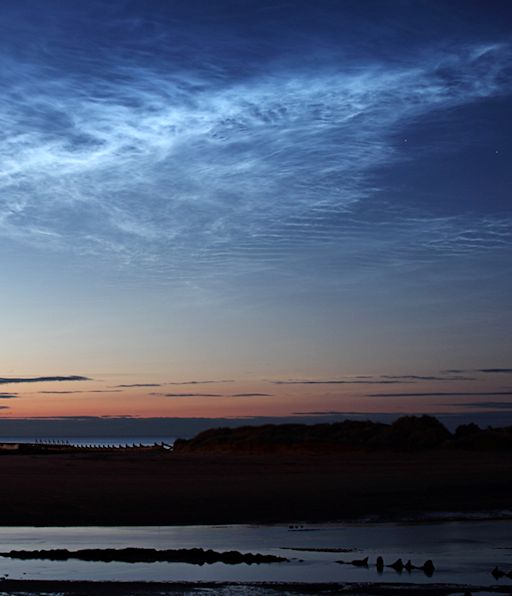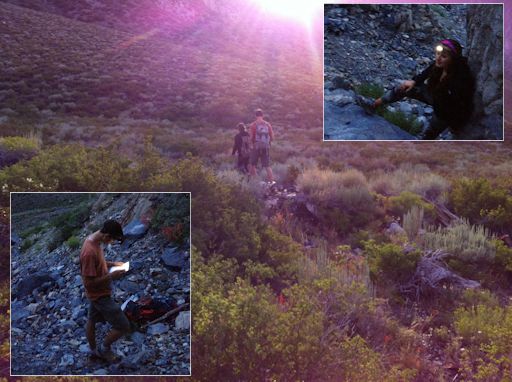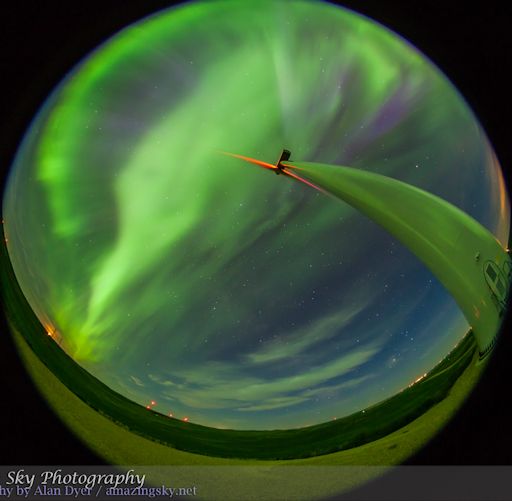When is the best time to see auroras? Where is the best place to go? And how do you photograph them? These questions and more are answered in a new book, Northern Lights - a Guide, by Pal Brekke & Fredrik Broms. | | |
ROCKET CRASH CAUGHT ON VIDEO: Yesterday, a Russian Proton-M rocket carrying three GLONASS navigation satellites crashed soon after takeoff from Kazakhstan’s Baikonur cosmodrome. Cameras near the launch site caught the mishap from beginning to end. Play the movie.
NOCTILUCENT CLOUDS INTENSIFY: The "noctilucent daisy" continues to expand and intensify as summer unfolds. Observers in central-to-northern Europe are reporting vivid, nightly displays of NLCs. Just hours ago, Alan Tough photographed these over Lossiemouth, Moray, Scotland:

"This was another spectacular display of noctilucent clouds," says Tough. "I arrived in Lossiemouth in time to see the Moon rising and managed to capture its glitter path on the River Lossie."
2013 is shaping up to be a good year for NLCs. The clouds surprised researchers by appearing early this year, and many bright displays have already been recorded. Once confined to the Arctic, NLCs have been sighted in recent years as far south as Utah, Colorado, and Nebraska. They might spread even farther south in 2013.
Observing tips: Look west 30 to 60 minutes after sunset when the sun has dipped 6o to 16o below the horizon. If you see luminous blue-white tendrils spreading across the sky, you've probably spotted a noctilucent cloud.
Realtime Noctilucent Cloud Photo Gallery
[previous years: 2003, 2004, 2005, 2006, 2007, 2008, 2009, 2011]
SPACE WEATHER BALLOON RECOVERY UPDATE: The western US is experiencing a record-setting heat wave with temperatures reaching 128 F and higher. How far up does the hot air go? To find out, a group of high school students in Bishop, CA, launched a research balloon to the edge of space on June 30th.
Update: The payload has since parachuted back to Earth in the Sierra Nevada mountains near Crowley Lake. A recovery team attempted to retrieve the payload yesterday, but their attempt was thwarted by sunset. There was not enough light to complete the ascent to the balloon's craggy landing site:

Another attempt is planned today, July 2nd. Starting the hike earlier will increase the team's exposure to heat, but also provide more light for payload hunting.
The payload contained two HD cameras, a pair of GPS trackers, a GPS altimeter, a cryogenic thermometer and an ozone sensor. The goal of this curiosity-driven experiment is to discover whether hot air near Earth's surface is able to "mix through" the tropopause to warm the stratosphere above. The group has been flying research balloons for nearly three years, so they have plenty of thermal data from previous flights to compare and contrast the effects of the extreme heat wave.
Realtime Space Weather Photo Gallery
WEEKEND GEOMAGNETIC STORM: On June 28, Earth passed through a region of south-pointing magnetism in the solar wind. The encounter set off one of the finest geomagnetic storms of the current solar cycle. At its peak on June 29th, the strong (Kp=7) storm filled the sky over Alberta Canasa with bright green auroras:

"With advance warning from Spaceweather.com, I headed out Friday night to a wind farm near my rural home, to take images of what I hoped would be an all-sky aurora. It did not disappoint!" says photographer Alan Dyer of Drumheller, Alberta. "These images are taken from the base of one of the massive wind machines, seemingly aimed into the aurora blown by the solar wind."
For a brief time, the auroras spilled across the Canadian border into the USA as south as Iowa, Oregon, Nebraska, and Kansas. In total, observers in more than a dozen US states reported visual or photographic sightings of auroras. Aurora alerts: text, voice.
Realtime Aurora Photo Gallery
Realtime Comet Photo Gallery

